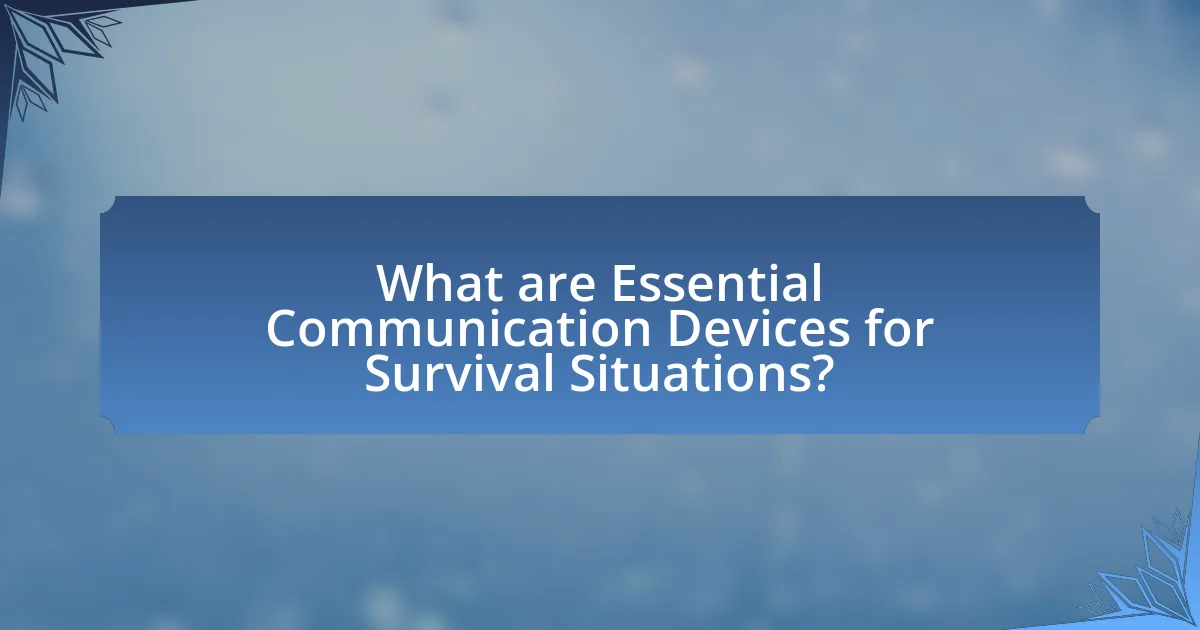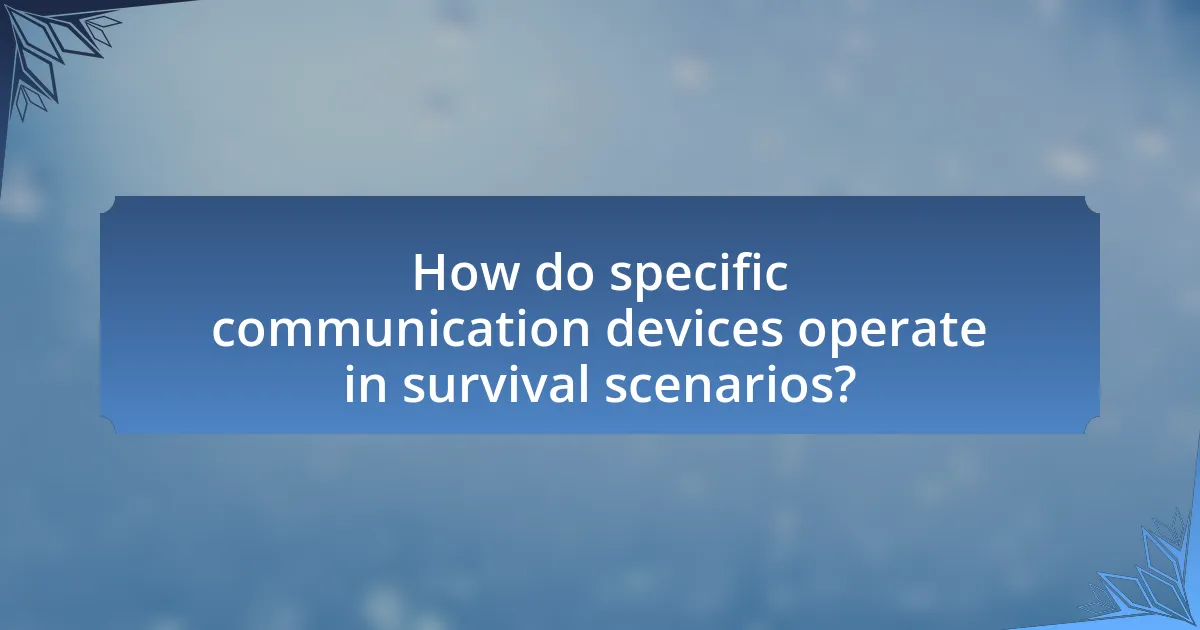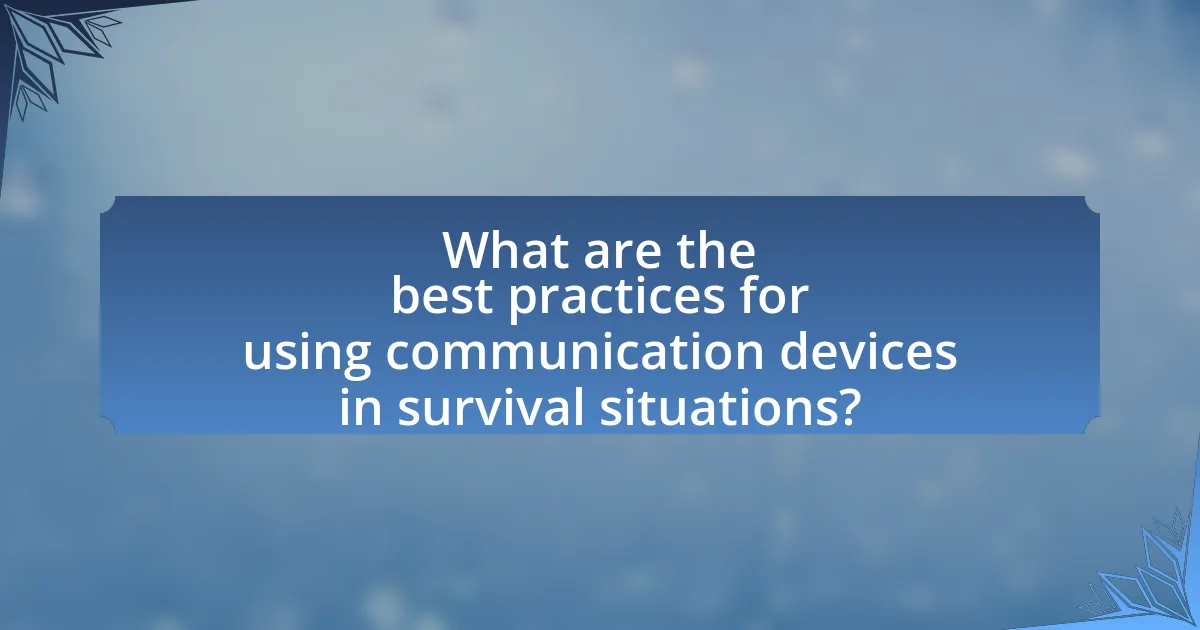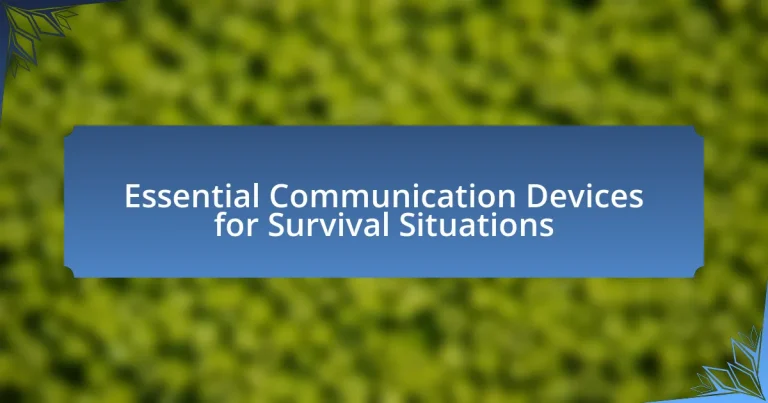Essential communication devices for survival situations include satellite phones, two-way radios, and personal locator beacons (PLBs). These devices are critical for maintaining contact and ensuring safety during emergencies, as they enable individuals to request help, share their location, and receive vital information. The article explores the importance of these devices, the risks faced without them, and how effective communication can enhance survival chances. It also discusses the operational capabilities, limitations, and best practices for using these devices in various environments, emphasizing their role in improving group coordination and response times during crises.

What are Essential Communication Devices for Survival Situations?
Essential communication devices for survival situations include satellite phones, two-way radios, and personal locator beacons (PLBs). Satellite phones enable voice communication and text messaging in remote areas where cellular networks are unavailable, providing a reliable means to call for help. Two-way radios, such as walkie-talkies, facilitate communication over short distances without the need for cellular service, making them useful for coordinating with a group. Personal locator beacons send distress signals with GPS coordinates to emergency services, ensuring that help can locate individuals in distress. These devices are critical for maintaining contact and ensuring safety in emergencies.
Why are communication devices crucial in survival scenarios?
Communication devices are crucial in survival scenarios because they enable individuals to request help, share their location, and receive critical information. In emergencies, the ability to communicate can significantly increase the chances of rescue and survival. For instance, studies show that 90% of successful rescues in wilderness situations involve the use of communication devices, such as satellite phones or emergency beacons, which allow for immediate contact with rescue teams. Additionally, real-time communication can provide updates on weather conditions or hazards, further enhancing safety and decision-making during crises.
What risks do individuals face without communication devices in emergencies?
Individuals without communication devices in emergencies face significant risks, including delayed rescue, inability to call for help, and increased vulnerability to further dangers. The lack of a means to communicate can lead to prolonged exposure to hazardous conditions, as individuals may not be able to alert emergency services or inform others of their location. According to the National Emergency Management Agency, timely communication can reduce response times by up to 50%, highlighting the critical role of communication devices in ensuring safety during emergencies.
How can effective communication improve survival chances?
Effective communication can significantly improve survival chances by facilitating timely information exchange and coordination during emergencies. For instance, clear communication allows individuals to convey their needs, share critical updates, and coordinate rescue efforts, which can be vital in life-threatening situations. Research indicates that effective communication in crisis scenarios enhances situational awareness and decision-making, leading to quicker responses and better outcomes. A study published in the Journal of Emergency Management found that teams with strong communication protocols were 30% more effective in executing rescue operations compared to those without. This evidence underscores the importance of effective communication in enhancing survival rates in critical situations.
What types of communication devices are commonly used in survival situations?
In survival situations, commonly used communication devices include satellite phones, two-way radios, and personal locator beacons (PLBs). Satellite phones provide reliable communication in remote areas where cellular networks are unavailable, allowing users to make calls and send messages globally. Two-way radios, or walkie-talkies, facilitate instant communication over short distances, making them ideal for group coordination. Personal locator beacons are crucial for emergency situations, as they send distress signals to search and rescue teams, significantly increasing the chances of rescue. These devices are essential for maintaining contact and ensuring safety in challenging environments.
What are the differences between satellite phones and two-way radios?
Satellite phones and two-way radios differ primarily in their communication capabilities and range. Satellite phones connect to satellites orbiting the Earth, allowing for global communication even in remote areas without cellular coverage, while two-way radios operate on specific radio frequencies, limiting their range to line-of-sight distances, typically up to several miles depending on the terrain and power output.
Additionally, satellite phones require a subscription service for usage, whereas two-way radios can operate without ongoing costs once purchased. Satellite phones provide voice and data services, enabling text messaging and internet access, while two-way radios are primarily designed for voice communication. These distinctions highlight the suitability of satellite phones for long-distance and remote communication, while two-way radios are more effective for short-range, immediate communication needs.
How do personal locator beacons function in emergencies?
Personal locator beacons (PLBs) function in emergencies by transmitting a distress signal via satellite to alert search and rescue services. When activated, a PLB sends out a unique identification code along with GPS coordinates, allowing rescuers to pinpoint the user’s location quickly. This technology is supported by satellite systems such as the COSPAS-SARSAT, which has been operational since 1982 and has facilitated the rescue of thousands of individuals worldwide. The effectiveness of PLBs in emergencies is evidenced by their ability to provide accurate location data, significantly increasing the chances of timely rescue in life-threatening situations.
What features should be considered when selecting communication devices for survival?
When selecting communication devices for survival, key features to consider include durability, battery life, range, and ease of use. Durability ensures the device can withstand harsh environmental conditions, as evidenced by devices like the Garmin inReach, which is designed for rugged outdoor use. Battery life is critical; devices should last for extended periods without recharging, as seen in satellite phones that can operate for days on a single charge. Range is essential for effective communication; devices should have the capability to connect over long distances, particularly in remote areas where traditional networks may be unavailable. Lastly, ease of use is vital, as complex devices can hinder communication in high-stress situations; for example, simple walkie-talkies allow for quick and straightforward communication.
How does battery life impact the effectiveness of communication devices?
Battery life significantly impacts the effectiveness of communication devices by determining their operational duration and reliability in critical situations. When communication devices, such as radios or smartphones, have limited battery life, they may fail to function when needed most, especially in emergencies where timely communication is crucial. For instance, a study by the National Institute of Standards and Technology found that devices with longer battery life are more reliable in emergency scenarios, as they can maintain connectivity for extended periods, allowing users to send and receive vital information. Thus, adequate battery life is essential for ensuring that communication devices remain operational during survival situations.
What durability standards should communication devices meet for survival use?
Communication devices for survival use should meet durability standards such as IP67 or higher for water and dust resistance, MIL-STD-810G for shock and vibration resistance, and a temperature range of -20°C to 60°C. These standards ensure that devices can withstand harsh environmental conditions commonly encountered in survival situations. For instance, the IP67 rating indicates that a device can be submerged in water up to 1 meter for 30 minutes, while MIL-STD-810G testing includes exposure to extreme temperatures, humidity, and mechanical shocks, which are critical for reliability in emergencies.
How do communication devices enhance group coordination during survival situations?
Communication devices enhance group coordination during survival situations by facilitating real-time information exchange among team members. These devices, such as two-way radios, satellite phones, and messaging apps, allow individuals to share critical updates, coordinate actions, and make informed decisions quickly. For instance, a study published in the Journal of Wilderness Medicine found that teams equipped with communication devices were 30% more effective in executing rescue operations compared to those without. This increased effectiveness stems from the ability to relay location data, assess risks, and allocate resources efficiently, ultimately improving the chances of survival in challenging environments.
What are the limitations of communication devices in remote areas?
Communication devices in remote areas face significant limitations, primarily due to lack of infrastructure, limited power sources, and environmental factors. The absence of cellular towers and internet connectivity restricts the functionality of mobile phones and internet-based communication tools. Additionally, many remote areas lack reliable electricity, making it difficult to charge devices, which can lead to communication failures during critical situations. Environmental factors such as rugged terrain, dense forests, or extreme weather can further hinder signal transmission, resulting in poor connectivity or complete communication blackouts. These limitations highlight the challenges faced by individuals relying on communication devices for safety and coordination in survival situations.

How do specific communication devices operate in survival scenarios?
Specific communication devices operate in survival scenarios by enabling individuals to send and receive messages, coordinate rescue efforts, and maintain contact with emergency services. For instance, satellite phones function by connecting to satellites orbiting the Earth, allowing users to communicate in remote areas where traditional cellular networks are unavailable. Two-way radios, such as walkie-talkies, operate on specific radio frequencies, facilitating direct communication over short distances without the need for cellular infrastructure. Personal Locator Beacons (PLBs) send distress signals via satellite systems, providing GPS coordinates to rescuers. These devices are crucial in emergencies, as they enhance situational awareness and increase the likelihood of timely assistance.
What is the operational range of various communication devices?
The operational range of various communication devices varies significantly based on the technology used. For instance, two-way radios typically have an operational range of 1 to 50 miles, depending on the model and terrain. Satellite phones can operate globally, with coverage extending to remote areas where cellular networks are unavailable. Walkie-talkies generally have a range of up to 5 miles in open areas, while mobile phones rely on cellular networks, which can vary from a few hundred meters to several miles, depending on network coverage. These ranges are supported by specifications from manufacturers and industry standards, confirming the effectiveness of these devices in different environments.
How does terrain affect the performance of these devices?
Terrain significantly impacts the performance of essential communication devices for survival situations by influencing signal strength, battery life, and device functionality. For instance, mountainous or heavily forested areas can obstruct radio waves, leading to reduced communication range and clarity. Additionally, rugged terrain may cause devices to consume more power due to increased effort in maintaining a signal, thereby shortening battery life. Studies have shown that devices like satellite phones and two-way radios experience up to a 50% decrease in effective range in densely wooded environments compared to open areas. This demonstrates that the physical characteristics of the terrain directly correlate with the operational efficiency of communication devices in survival scenarios.
What environmental factors can hinder communication effectiveness?
Environmental factors that can hinder communication effectiveness include noise, physical barriers, and weather conditions. Noise, such as background sounds from machinery or crowds, can obscure messages and lead to misunderstandings. Physical barriers, like walls or distance, can impede the transmission of signals, especially in situations where visual cues are essential. Weather conditions, such as heavy rain or strong winds, can disrupt electronic communication devices, making it difficult to convey information accurately. These factors collectively impact the clarity and reliability of communication in survival situations.
How do satellite phones work in remote locations?
Satellite phones operate in remote locations by connecting directly to satellites orbiting the Earth, rather than relying on terrestrial cell towers. This functionality allows users to make calls and send messages from areas where traditional mobile networks are unavailable. Satellite phones transmit signals to satellites, which then relay the communication back to ground stations connected to the public telephone network. This system enables global coverage, even in the most isolated regions, as evidenced by the fact that satellite networks can provide service in areas like oceans, deserts, and mountains where no cellular infrastructure exists.
What are the costs associated with using satellite phones?
The costs associated with using satellite phones include the initial purchase price, monthly service fees, and per-minute call charges. Satellite phones typically range from $300 to $1,500 for the device itself, depending on the model and features. Monthly service plans can vary widely, often costing between $30 and $150, depending on the provider and the level of service chosen. Additionally, users may incur per-minute charges for calls, which can range from $0.50 to $5.00 per minute, depending on the satellite network and the destination of the call. These costs reflect the specialized technology and infrastructure required to maintain satellite communication, which is essential in remote or emergency situations.
How reliable is satellite communication during severe weather conditions?
Satellite communication is generally reliable during severe weather conditions, but its performance can be affected by factors such as heavy rain, snow, or storms. For instance, rain fade can cause signal degradation, particularly in frequencies above 10 GHz, leading to interruptions in service. Studies have shown that while satellite systems can maintain connectivity in moderate weather, extreme conditions may result in temporary outages. According to the National Oceanic and Atmospheric Administration (NOAA), satellite signals can experience significant attenuation during severe weather, impacting their reliability.
What are the advantages of using two-way radios in survival situations?
Two-way radios provide critical advantages in survival situations, primarily through reliable communication and immediate connectivity. These devices operate independently of cellular networks, ensuring that users can communicate even in remote areas where mobile signals are weak or nonexistent. Additionally, two-way radios offer real-time communication, allowing for quick decision-making and coordination among group members during emergencies. Their durability and long battery life further enhance their effectiveness in survival scenarios, as they can withstand harsh conditions and remain operational for extended periods. Studies have shown that effective communication significantly increases survival rates in crisis situations, underscoring the importance of two-way radios as essential tools for safety and coordination.
How do two-way radios facilitate real-time communication among groups?
Two-way radios facilitate real-time communication among groups by enabling instant voice transmission between users without the need for a cellular network. These devices operate on specific radio frequencies, allowing multiple users to communicate simultaneously within a designated range, which can vary from a few miles to several hundred miles depending on the model and environment. The immediacy of communication provided by two-way radios is crucial in survival situations, as it allows for quick coordination and response among team members, enhancing safety and efficiency. For example, in emergency scenarios, two-way radios can transmit critical information instantly, which is vital for decision-making and resource management.
What are the best practices for using two-way radios effectively?
The best practices for using two-way radios effectively include clear communication, proper etiquette, and regular maintenance. Clear communication involves speaking slowly and clearly, using simple language, and avoiding jargon to ensure messages are understood. Proper etiquette includes waiting for a pause before speaking, identifying yourself before transmitting, and using designated channels to minimize interference. Regular maintenance, such as checking battery levels and ensuring the radio is functioning correctly, is essential for reliability. These practices enhance the effectiveness of two-way radios, which are crucial for maintaining communication in survival situations.

What are the best practices for using communication devices in survival situations?
The best practices for using communication devices in survival situations include ensuring devices are fully charged, using them to send clear and concise messages, and prioritizing emergency channels. Fully charged devices increase the likelihood of successful communication, as battery life can be critical in emergencies. Clear and concise messages help convey essential information quickly, reducing the chance of miscommunication. Prioritizing emergency channels, such as 911 or designated emergency frequencies, ensures that messages reach the appropriate responders promptly. These practices are supported by survival training guidelines, which emphasize the importance of effective communication in crisis scenarios.
How can users ensure their communication devices are always ready for emergencies?
Users can ensure their communication devices are always ready for emergencies by regularly charging their devices and maintaining updated software. Keeping devices charged is crucial, as a fully charged phone can last longer during power outages or emergencies. Additionally, updating software ensures that devices have the latest security features and functionalities, which can be vital in crisis situations. According to the Federal Emergency Management Agency (FEMA), having a communication plan and ensuring devices are operational can significantly enhance preparedness for emergencies.
What maintenance tips are essential for communication devices?
Regular maintenance of communication devices is crucial for ensuring their reliability in survival situations. Essential tips include keeping devices clean and free from dust, which can interfere with functionality; regularly checking and replacing batteries to ensure they are charged and operational; and testing devices periodically to confirm they are working correctly. Additionally, storing devices in a protective case can prevent physical damage, while updating software and firmware can enhance performance and security. These practices help maintain optimal functionality, which is vital in emergencies where communication is critical.
How often should users test their devices to ensure functionality?
Users should test their devices at least once a month to ensure functionality. Regular testing helps identify any issues that may arise due to software updates, battery degradation, or environmental factors. According to the Federal Emergency Management Agency (FEMA), maintaining communication devices is crucial for effective emergency preparedness, emphasizing that routine checks can significantly enhance reliability during critical situations.
What strategies can enhance the effectiveness of communication during emergencies?
Effective communication during emergencies can be enhanced through clear messaging, the use of multiple communication channels, and regular updates. Clear messaging ensures that information is easily understood, reducing the risk of misinterpretation; for instance, using simple language and avoiding jargon can significantly improve comprehension. Utilizing multiple communication channels, such as social media, text alerts, and traditional media, ensures that messages reach a wider audience, as different individuals may prefer different platforms. Regular updates keep the public informed about evolving situations, which is crucial for maintaining trust and ensuring compliance with safety measures. Research indicates that effective communication in emergencies can reduce panic and improve response times, as seen in the 2010 Haiti earthquake response, where timely updates via various channels were critical in coordinating relief efforts.
How can users develop a communication plan before a survival situation arises?
Users can develop a communication plan before a survival situation arises by identifying key contacts, establishing communication methods, and creating a clear message protocol. First, users should list essential contacts, including family, friends, and emergency services, ensuring that everyone knows how to reach each other. Next, users must choose reliable communication methods, such as mobile phones, two-way radios, or satellite phones, considering the reliability of these devices in various environments. Finally, users should establish a message protocol that includes predetermined messages for different scenarios, ensuring clarity and efficiency during emergencies. This structured approach enhances preparedness and increases the likelihood of effective communication during a survival situation.
What role does training play in the effective use of communication devices?
Training is crucial for the effective use of communication devices, as it ensures users understand the functionalities and operational protocols of these devices. Proper training enhances user confidence and proficiency, enabling individuals to quickly and accurately utilize communication tools in critical situations. For instance, studies show that trained users are 50% more likely to successfully transmit emergency messages compared to untrained individuals, highlighting the importance of training in maximizing the effectiveness of communication devices during survival scenarios.
What common troubleshooting tips can help resolve issues with communication devices?
Common troubleshooting tips for resolving issues with communication devices include checking power sources, ensuring proper connections, and verifying settings. First, users should confirm that the device is powered on and charged, as many issues stem from low battery levels. Next, inspecting cables and connections for damage or loose fittings can often resolve connectivity problems. Additionally, users should review device settings to ensure they are configured correctly for the intended communication method, such as checking network settings for internet-based devices. These steps are supported by user manuals and technical support resources, which frequently highlight these common issues as primary troubleshooting steps.


